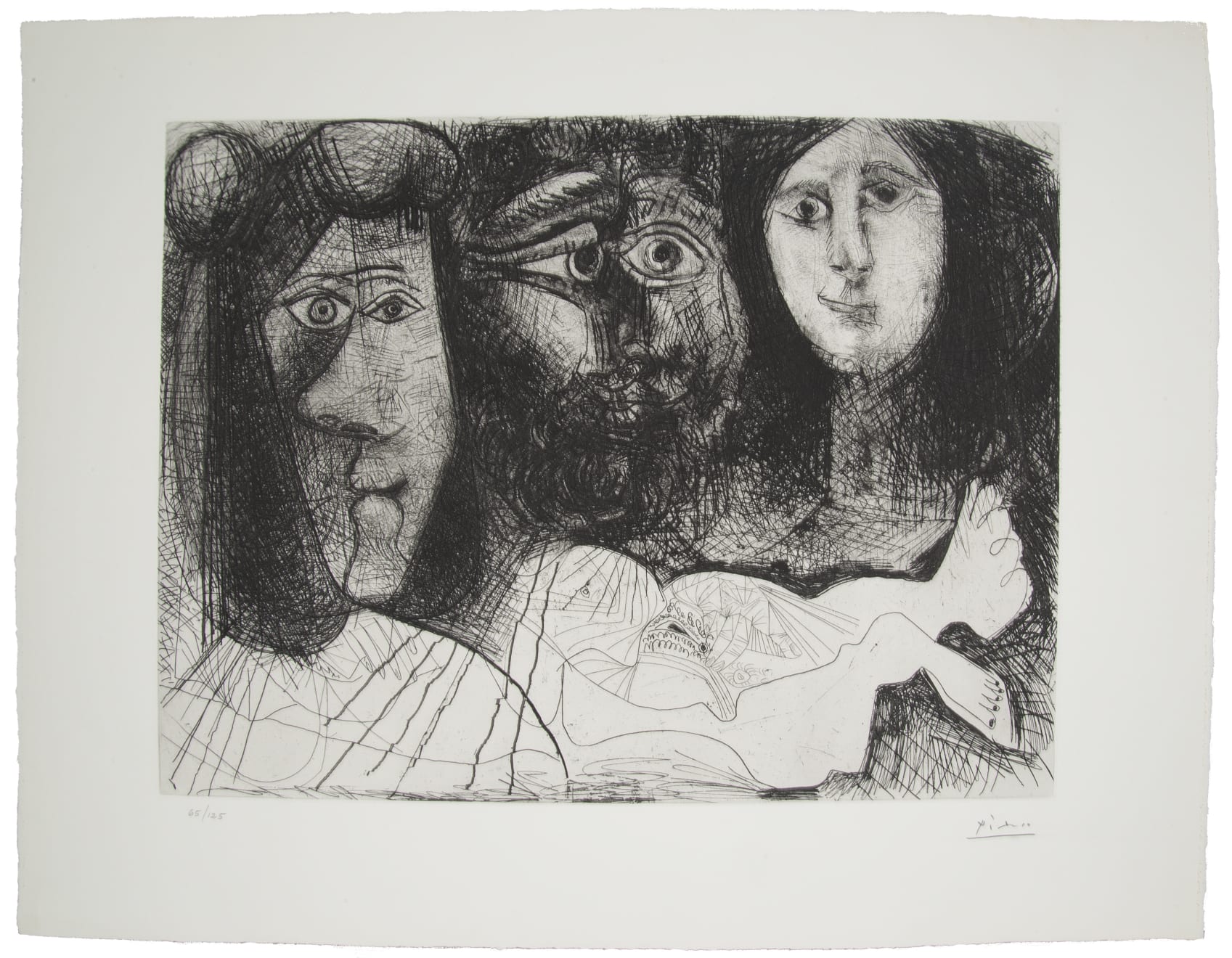PABLO PICASSO
Album containing an original etching, seven color reproductions of Picasso's maquette for La Chute d'Icare, reproductions of preparatory drawings, and a preface by Jean Leymarie
Numbered 46 on the colophon page
Printed by Imprimerie Roto-Sadag S.A. and Imprimerie Atar S.A, Geneva, 1972
Published by Albert Skira, Geneva, 1972
Dimensions: 28 1/8 x 21 1/2 inches
(Cramer 155)
The etching:
Autoportrait, avec Deux Femmes
1972 (March 4 and 6, Mougins)
Etching and drypoint with scraper printed on Rives
From the edition of 125 of the thirteenth (final) state
Signed in pencil, lower right
Numbered 46/125 in pencil, lower left
Printed by Crommelynck, 1972
Image: 14 3/8 x 19 3/8 inches
Sheet: 19 3/4 x 25 7/8 inches
(Bloch 2016) (Baer 2022.XIII.B.b)
Literature
During an artistic career that spanned seven decades, Picasso illustrated a total of 156 books, including literary folios, albums and exhibition catalogues. A talented and prolific draughtsman, his first exercise in illustration was for the Poèmes of André Salmon, published in Paris in 1905. Autoportrait, avec deux femmes is one of Picasso’s last prints; it featured as the frontispiece for the final book that he illustrated—La Chute d'Icare, published by Albert Skira in Paris in 1972. But its history goes back to nearly twenty years before.
In October 1957, Picasso was commissioned to paint a mural for the UNESCO Paris headquarters, which were to be inaugurated the following year. Shortly after completing his variations on Velásquez’s Las Meninas, in December 1957 Picasso began making studies for the commission, filling two notebooks with sketches of bathing figures and nudes, in the style of his series of Bathers from 1956. The mural was installed in the conference hall foyer of the Paris UNESCO headquarters in September 1958, made of forty wooden panels, and covering a surface of one hundred square meters. It represents an abstracted beach scene in which a figure—‘a sort of anthropomorphic bird-fish’ (Cramer 155)—appears to be falling into the Mediterranean blue sea, blankly witnessed by a group of standing and reclining figures. No definitive conclusions as to the artist’s symbolic intentions have been made, though many interpretations have circulated. Initially entitled The Forces of Life and the Spirit Triumphing over Evil, the composition was renamed in 1958 by the art historian George Salles, then acting Vice President of the UNESCO committee of art advisors, who preferred the current title, The Fall of Icarus, as an allegory of a struggle between good and evil. Picasso himself suggested only that the mural showed, ‘des gens qui se baignent, tout simplement’ (a simple scene of bathers). Whatever the artist’s real intentions in the image, the heavy rounded black outlines around the falling figure’s skinny white limbs, which isolate it from the surrounding blue of the sea, confer a sense of danger and foreboding that is not in any way allayed by the other characters on the beach.
Autoportrait, avec deux femmes is dated March 4, 1972 and is Picasso’s last major print by virtue of its size and complexity (the last, Bloch 2011, was done March 25, 1972). Its significance for the artist is indicated by the many states he took it through—thirteen altogether—with major changes in the imagery at certain points in the process. In the first state, a young naked couple is depicted resting on the left; as the states progress they disappear little by little, leaving only the female genitalia visible, around which the body of a reclining nude forms itself. As the couple disappears, three faces hovering above it become apparent, emerging from the darkening background as though they are phantoms slowly forming in mist, perhaps the memories of the artist’s ninety years surfacing in his mind. Although it has been nearly obliterated by the intense linear texture that Picasso built up above it, the body of the reclining nude—in particular her genitals, the focal point of the print—recalls the imagery of Suite 156, Picasso’s last series of etchings that he was working on at the same time, in which the eroticism of the relationship between the artist and his model is frequently celebrated. As in one of these, ‘Ecco Homo’, d’après Rembrandt, the face of the artist is in the centre of the image, flanked by his female companions, but rather than observing the nude in the light below him, here he is looking sideways and inwards—suggesting a contemplation of death. His beard is that of his father, Don José, a painting teacher known for his pictures of doves. The women’s heads on either side appear as spectres of femininity who haunt the ageing artist—his lifelong companions, neither they, nor the female body on overt offer to his consumption below can stave off the darkness that threatens to swallow the artist at the end of his life.
In 1972, Albert Skira—a Geneva publisher and friend of Picasso’s—initiated a publishing project with Jean Leymarie, the director of the Musée national d’art moderne in Paris. Together they had published the book Picasso Métamorphoses et Unité on the occasion of the artist’s ninetieth birthday the previous year. This new publication was a group of studies for Picasso’s UNESCO mural, collected under the same title, La chute d’Icare. The album contains seven lithographic colour reproductions of Picasso’s studies for the mural, as well as eighty reproductions of preparatory drawings, accompanied by an essay by Leymarie in which he traces the origins of the project. The final state of Autoportrait, avec deux femmes was selected to accompany the first 125 copies of Skira’s portfolio(ten hors commerce copies were similarly accompanied). A further 375 copies were printed without the etching.
